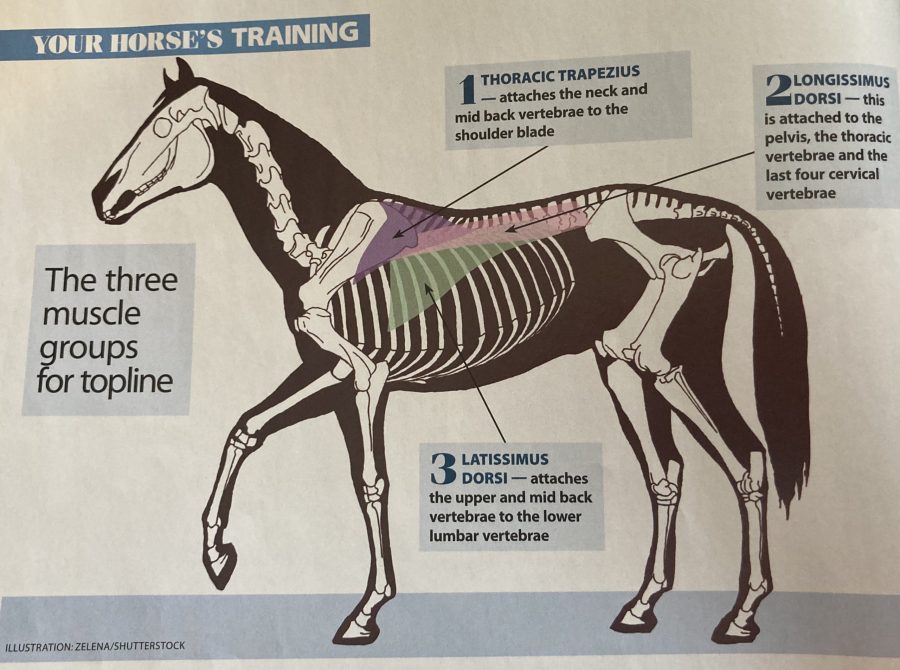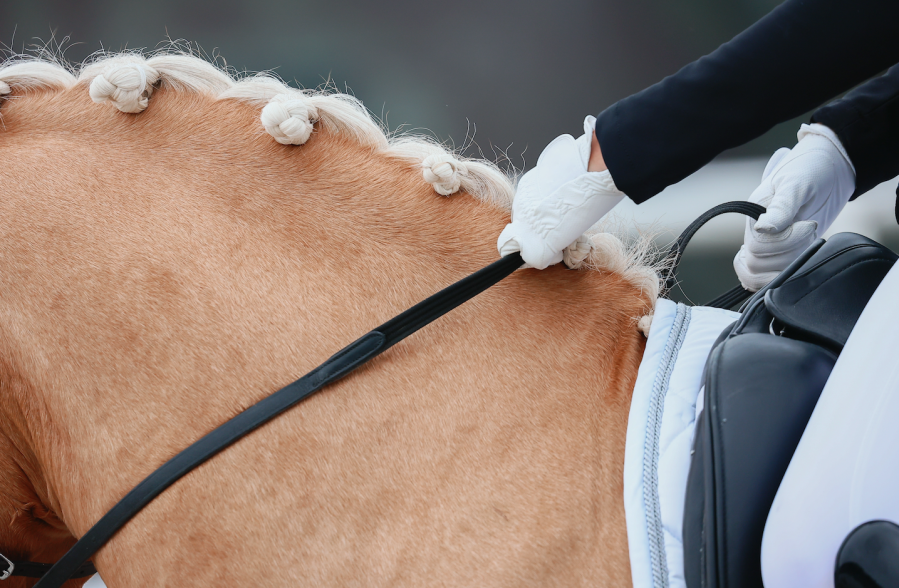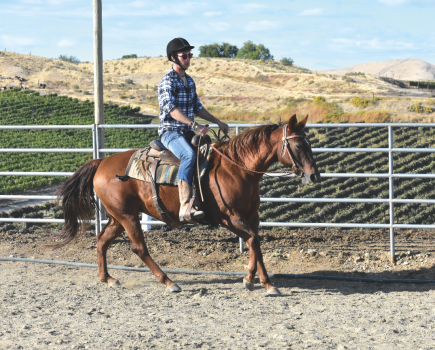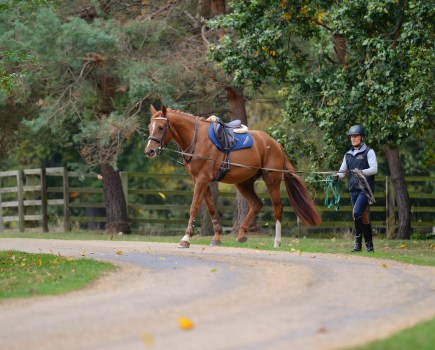‘Poor topline’ is a term us riders hear regularly. It plays a vital role in supporting your horse’s body, the weight of you, their rider, and the saddle they are carrying, as well as facilitating movement.
Topline refers to the group of muscles that run along a horse’s spine from the top of the neck to the wither area, down the back and loin, and over the top of the hip into the croup region. So a big portion of the horse’s body makes up their topline and it has several essential roles to fulfil — that’s why a horse with poor topline needs to be worked and ridden correctly to improve it.
What is topline?
Topline involves three muscles in the horse’s neck:
- Thoracic trapezius
- Longissimus doors
- Lattisimus dorsi (more on these last two later).
There is also a big clue in the name: topline is located along the top of the horse’s neck and not at the bottom. However, you will see horses with more prominent muscle at the bottom of their neck (and therefore a poor topline) if they are not ridden in a correct outline.
“The purpose of the muscles around the spine are to hold it firm when the horse is generating force through his hindquarters,” explains ACPAT veterinary physiotherapist Gillian Tabor. “As prey animals, to be successful in running away from a lion, the horse has to be able to transmit force from his hindquarters all the way through his body.
“The way he does that is to contract the muscles around the spine to create a rigid back to then be able to gallop efficiently. If it was weak and wobbly he would lose so much energy that he wouldn’t be able to run fast.”
Where is a horse’s topline?

A diagram of the muscle groups used for topline
Three muscle groups are used for a horse’s topline. They are:
- Thoracic Trapezius — attaches the neck and mid back vertebrae to the shoulder blade
- Longissimus Dorsi — this is attached to the pelvis, the thoracic vertebrae and the last four cervical vertebrae
- Latissimus Dorsi — attaches the upper and mid back vertebrae to the lower lumbar vertebrae
What does poor topline look like?
Sometimes it can be quite hard to distinguish fat from muscle, especially on the horse’s neck. Fat is poor topline; muscle is good.
“If the horse has got a crest on his neck because he is fat, he will have fat pockets in other places too,” says Gillian. “If you look at a body condition scoring chart, he will have fat over his loins and shoulders, tail head and a large tummy.
“When assessing topline, we are looking for a rounded shape, especially over the quarters, with no prominent bony processes other than the withers. The profile across the back should be slightly rounded, maybe even a little convex. In a poorly muscled horse, you can see the spinous processes prominently and the pelvis looks very angular. The top of the tail and sacrum appear concave.”
Gillian uses her own ‘cheese scale’ to assess muscle.
“Good muscle should feel like just underripe brie and there should be a little bit of rebound to it, with no spasm or response to it being palpated,” she says. “Poor muscle can feel like an overripe brie where your fingers sink into it and disappear, or a dried-out cheddar which has a solid feel to it.”
How to improve a horse’s poor topline
Before starting any muscle-building programme, the first thing is to exclude pain. This should include checking your horse’s saddle fit and foot balance, as well as a physical examination by a vet.
“If a horse is in pain, they won’t work correctly and you won’t build muscle,” says Gillian. “Once pain has been excluded, you want to work your horse in a posture that is activating the muscles you want to develop. It’s no good reinforcing a movement pattern where the horse’s head is up, their back is in extension and hollowed and their hindlegs aren’t engaged.”
The following four reasons could cause a horse to have poor topline:
- Pain and change in movement
- Nutritional issues
- Exercise (lack of/working incorrectly)
- Saddle fit/rider issues
What is the correct posture for building topline?
The correct posture is where the horse’s head and neck are slightly lowered, and the ears are level with the withers. The horse’s neck should be horizontal and their nose slightly in front of the vertical.
“If the head is too far down, and they look like they are sniffing the ground, it means they are putting a lot of weight on the forehand and not switching on the right muscles,” explains Gillian. “When the horse is in the correct position, we are looking for them to activate their core muscles and lift up through their back.
“They should flex their hindlimbs so they bend through their hip, stifle, hock and fetlock as they swing their leg forward. We also want them to reach forward underneath their body and tuck their pelvis in with each hind step. This creates hindlimb engagement.”
How long does it take to improve poor topline?
Be patient! Muscle doesn’t happen overnight. Visible muscle changes take a good six to eight weeks. You increase the number of muscle fibres that work inside the muscle to start with, which is why you get an apparent increase in strength and function, but the development of muscle is a much slower process. Three signs you’re overdoing it are stiffness, behavioural changes and lack of progress in your horse.
By covering a variety of ridden, lunging and in-hand groundwork exercises, you will work the required muscles in your horse as well as prevent you both from becoming bored. Try these four exercises from Gillian:
1 Spiral in and out on the lunge
“A key exercise for improving poor topline is spiralling in and out of a circle on the lunge. The special features about this is that because you have lateral bend, you have a slightly different action to the muscles on the inside as the muscles on the outside.
“To be straight on the circle, the outside hindleg and foreleg have to take a slightly bigger stride and you are not just challenging the muscles that flex, extend and move the limb on a straight line, you are also working the muscles that work on abduction and adduction. That is asking for more effort than going on a straight line.”
How to do it:
- In trot, start on a 20m circle and then reduce the size by bringing your horse onto a 10m circle.
- To bring them in, shorten the lunge line so that your horse turns their nose off the line of the 20m circle. Then they will wind in towards you.
- To ask them to go back out onto the bigger circle, walk a larger circle yourself so they stay the same distance from you. You want a little drift to the outside, so the horse’s weight is taken to the outside.
- You want the horse bent in the direction you want to go, so their ribs are flexed to the outside but the inside hindleg steps up and underneath to lift them up. Once you’re in this carrying position, if you can maintain it, you are then working those muscles.
- It will take two or three circles to get back onto the bigger circle. It’s hard work, so two or three circuits of each size before changing the rein is plenty.
2 Step under with the hindleg
Groundwork is a key part of your training and can be used for warming up and before lunging. It’s about relaxation, coordination of the body and posture. This exercise can be done before a ridden or lunge session and while tacked up.
How to do it:
- Begin by leading your horse on a small circle in walk, replicating the same posture as on the lunge, so a forward and down head carriage with your horse bent around you and stepping underneath with their inside hindleg.
- As they turn, you want them to step their hindleg forward and underneath their body, which will then encourage the horse to lift up through the core into the carrying posture in the back.
- You can progress this into a shoulder-in along a wall by asking for a gentle sideways movement.
3 Do regular carrot stretches
Stretches are great for recruiting the muscles that lie deeper around the spine and help to stabilise it. This is a good help towards improving poor topline.
How to do it:
- Do carrot stretches to each side and between your horse’s front legs. The lower the end position of their head, the better the lift through the thoracolumbar (main back) region. These are best done after exercise when your horse is warm, or after they’ve been in the field. Do them daily if possible.
- If your horse is on box rest or not warmed up, start with a smaller range of motion, doing between three and five of each stretch.
- Get someone to show you how to avoid your horse ‘cheating’ and how to achieve a good quality of movement.
- Take care of the surface your horse is standing on. It should be non-slip.
- Consider positioning. You can put your horse in the corner of the stable or arena to help keep their body still.
4 Work on a hill
Hill work is an excellent way to build a horse’s topline under saddle.
“Riding up and down hills increases the activity of the muscles in the hindquarters, the back and the abdominal muscles,” states Gillian.
How to do it
- A slow trot or walk is going to be most beneficial in the early stages.
- Again, you want the right posture and head carriage with your horse lifting and stepping under so they are pushing up the hill rather than pulling on the forehand.
- With regards to the rider’s position, your upper body is perpendicular to the horizontal, so the steeper the hill, the more forward a position you should take — but, ultimately, you want to stay balanced and light in the saddle.
- If it’s a long, steep hill, walk up it just once or twice. Walking downhill is just as good because your horse needs to control their descent and flex the hindlegs to step under their body and shift the weight backwards.
- You want a nice slow descent, allowing your horse to balance themselves. Allow freedom of the head as long as it isn’t too high or hollow.
5 Feed for correct topline
Building topline and correcting poor topline isn’t just about exercise, it also requires the correct nutrition.
“In order to build muscle your horse needs to be in a positive energy balance, which means he is receiving slightly more energy than he needs for the work he is doing,” explains scientist Dr David Marlin. “The second requirement is to have sufficient quality of protein and we judge that by the amount of lysine.
“Lysine is considered to be the number one limiting amino acid, so if you don’t have sufficient lysine in terms of grams per day for the work your horse is doing, he won’t develop muscle. In the same breath, feeding too much won’t have any effect. Once you’ve reached the minimum requirement, feeding a big excess is a waste,” continues David.
“For a 500kg horse in light work you’d typically need 800g of protein a day, whereas a horse in hard work would need 1,300g of protein a day, so that equates to 9g of lysine, which isn’t much.”
Leucine (HMB) has also been shown to have beneficial effects on both muscle development and soreness, but only if fed in large amounts and shortly after exercise.
Speak to your vet and nutritionist to discuss your horse’s feeding plan.
Main image: © Shutterstock; Inset: © Your Horse Library/Kelsey Media
Related content
- What are the Scales of Training in dressage?
- Should you hack out with your horse on a contact?
- Lunging a horse: how to make sure they are working correctly
- Groundwork exercises: three interesting ways to work your horse’s core
- Fit or fat? Learn to assess your horse with this body condition scoring guide








